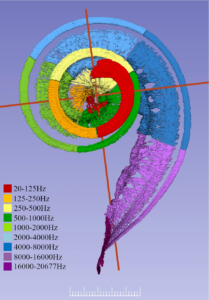Personalized medicine: suitable CI electrodes for everyone!
It can take up to three years for CI users to perceive the pitch correctly – or at all – if the CI electrode is too short! Only MED-EL enables true-to-sound hearing right from the start: with custom-fit CI electrodes as well as electrode planning and anatomically correct fitting with the help of OTOPLAN.

Sometimes we hear from individual CI users that their cochlear implant sounds "tinny", "like a robot", "reverberant" or "metallic". These are typical distortions of the sound image if the electrode only covers part of the cochlea; if the electrode used is too short for the individual cochlea.
In natural hearing, the sensation of pitch is distributed along the entire length of the cochlea. Cochlear implants use this tonotopic arrangement: for a low-frequency sound, a contact at the tip of the electrode stimulates the neuronal structure; for a high-pitched sound, a contact at the entrance to the cochlea.
The length of the electrode matters!
A short CI electrode cannot cover the two turns or 720 degrees of a typical cochlea. In this case, even the contact that is furthest in the cochlea tip cannot reach the area for low-pitched sounds in the cochlea tip. Low tones are then stimulated, for example, at the location for medium pitch perception. Sound fidelity is not possible this way: everything sounds more like "Mickey Mouse" or a "robot".

Personalized medicine in ENT - with MED-EL and OTOPLAN ©MED-EL
MED-EL offers the only electrodes that are long enough for a typical cochlea: the Standard and Flex-Soft electrodes. A new addition is the Flex34 electrode for CI candidates with an extra-large cochlea. The surgeon can use the OTOPLAN planning software to find out which of these electrodes is required before the operation begins - and the CI technician or speech therapist can use the software to see which sound area should be stimulated via which contact.
Unique electrode design for tonotopic conformity
If you were to roll out a typical human cochlea until it was straight, it would be 32 millimetres long. Individually, this length can vary by up to 50 percent - between 25 and 36 millimeters! Many CI manufacturers offer electrodes of different lengths. However, even the longest electrodes from most manufacturers can only cover the first turn of the cochlea. With these types of electrodes, it can take years for users to get used to the associated sound - if at all.

Complete coverage of an average-sized cochlea with a Flex-Soft electrode ©MED-EL
This is particularly unpleasant for users who have normal hearing in the other ear or hear through a conventional hearing aid. The results of a recent study with unilaterally deaf CI users in the USA showed that this unnaturally high perception of sound can persist for several years after CI activation.
The study also confirms older studies that showed a division of pitches within the cochlea can be learned during many years of CI use - but this relearning does not always work equally well.
Natural sound for all cochlear sizes!
The Austrian company MED-EL is the only CI manufacturer to offer really long yet flexible electrodes. They cover up to two full turns of the cochlea and extend to the tip of the cochlea. MED-EL has been offering electrodes with a length of 32 millimeters since 1994!
This allows a typically long cochlea to be stimulated tonotopically correctly. A selection of shorter electrodes is available for CI candidates with a smaller cochlea. For over 25 years, MED-EL has therefore been providing 95 percent of CI candidates with electrodes for near-natural pitch perception. In everyday life, this means better hearing and optimal hearing sensation with a CI.
Electrodes for cochleae in size XL
At the beginning of 2023, MED-EL introduced an even longer electrode for the remaining 5.1 percent of CI candidates: the FLEX 34! At 34 millimeters, it has the extra length to stimulate tonotopically correctly even in an XL cochlea. Six FLEX electrodes in lengths between 20 and 34 millimeters enable CI surgeons to select the optimum electrode length for each CI candidate. The OTOPLAN planning software helps the surgeons to do this.

Soft tissues from ten cochleae in orthographic 3D view. Frequency maps of the basilar membrane according to Greenwood (1961)
Adapt the implant to the patient, not the patient to the implant!
OTOPLAN is both a DICOM viewer and surgical planning software for CI and BONEBRIDGE implants. It comes from the Swiss manufacturer CASCINATION. A DICOM viewer is a program that can display radiological cross-sectional images of a computer tomography CT or a magnetic field tomography MRI in cross-sectional views and as a three-dimensional view.
OTOPLAN can combine the data sets of several such MR and CT images in one display. Special functions have been implemented in the planning area of OTOPLAN for cochlear implantation: This allows the surgeon to determine the most favorable position of the implant and the optimal electrode length before the operation begins.
Personalization also during the CI system activation
If a CT or MR scan is performed again after implantation, OTOPLAN can automatically recognize the position of the electrode contacts. It can also automatically transfer this information to the CI system's fitting software so that the pitches are stimulated in the right place for each individual user.
The optimally selected electrode in combination with anatomically-based fitting enables users of MED-EL cochlear implants to experience a more natural frequency response and a more natural sound image.






